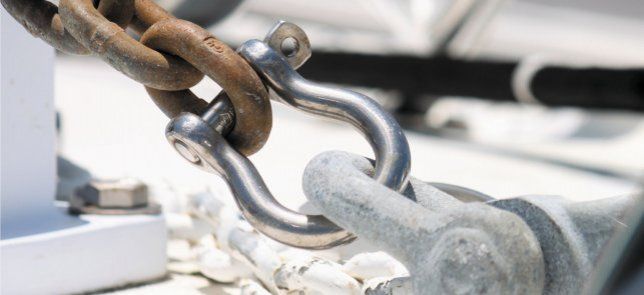No matter what brand of anchor shackle you decide to use, understanding sizing and grades of shackles is essential, since this connector between your rode and anchor is often the weakest link in your ground tackle. The maximum size of your anchor shackle is limited by the size of your anchor-chain links. Typically, you can go up one size greater than the nominal size of our links-i.e. a 5/16-inch chain can take a 3/8-inch shackle, but the surest way to ensure that you are getting the right size is to take a few connected links of chain with you to the chandlery and make sure the shackle pin actually fits the hole.
The most common types of anchor chain BBB, G30, G43, and metric chain all have varying chain-link hole sizes for ostensibly the same diameter (thickness) wire. Shackles of the same nominal size also vary; even the shackle-pin diameter varies. Except when buying matching chain and shackles from the same manufacturer, take nothing at face value-test fit first. When buying chain in bulk, some vendors allow you to order chain with oversized links at each end, making it easier fit the larger shackle pins; this is a good option for those who prefer high-strength G43 chain. Quality control is imperative. As we discovered in our most recent round of anchor shackle testing, there is a wide range of quality among shackles that are nearly identical in appearance.
The other critical factor is strength. Ideally, the shackle should be stronger than the anchor chain. However, achieving this becomes difficult once you start moving into chains rated G43 or higher. The 3/8-inch shackles we look at in our test should fit common 5/16-inch proof-tested chain stamped G30 (7,600 lbs. nominal breaking strength) or G43 chain (11,400 lbs. nominal breaking strength). For more on chain standards and breaking strengths, including those for metric chains, see Making Sense of Marine Chain Standards.
However, safety margin becomes even smaller when the effects of side-loading are taken into account.
When the shackle pin or body is loaded from an angle, the shackle body can be forced open, causing the pin to break or fall out. This is the most common failure we have seen in our tests-even though our test involved a straight pull. According to warnings posted by several manufacturers, a 45-degree side load can reduce the shackles rated strength by 25 percent, and a 90-degree load can reduce it by 50 percent.
Fortunately, high quality shackles have a safety factor of between 4:1 to 6:1, meaning the actual failure point is four to six times greater than the rated working load; so, in theory, a good shackle is capable of handling side loads.
How do we identify a good shackle? In the U.S., shackle standards are spelled out in RR-C-271F, Federal Specification for Chains and Attachments, Carbon and Alloy Steel. In our most recent report, we are focused mostly on Class 2 (screw-pin) shackles that meet or exceed RR-C-271F IVA Grade B Class 2 specifications.
Other classes will meet these working load requirements- Class 3 shackles, secured with bolt, nut and cotter-pin instead of a screw pin, for example-but the essential nomenclature here, is Grade B. This grade has twice the strength of the more common Grade A shackle. This may seem counter-intuitive, but one way to remember this is to remember: B is Better.
If you are serious about anchors, anchor chain, and anchoring accessories like snubbers, chain hooks, and windlasses, or you are just curious about the best anchoring technique-check out our 4-part ebook featuring a complete selection of tests of anchor chain, swivel shackles, and other anchoring accessories. Profits from this and all our other ebooks, available in our online bookstore, help support further tests like this anchor shackle test. Practical Sailor accepts no advertising.







































Curiously, have you tested bolt type shackles like Crosby G-2140? I was reading this type of shackle is the only one to use for “permanent or long-term applications, or if there”s a risk of a load sliding on the shackle pin, causing it to rotate.”
How save are hammer links or twin clevis links if loads are followed ?